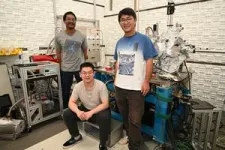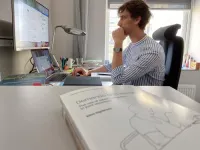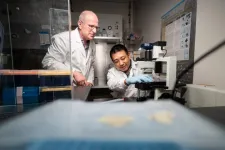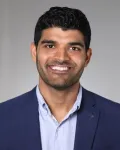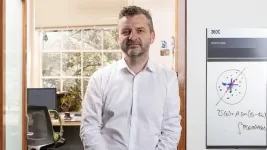(Press-News.org) UPTON, NY—In the field of superconductivity—the phenomenon in which electrons can flow through a material with essentially zero resistance—the “holy grail” of discovery is a superconductor that can perform under everyday temperatures and pressures. Such a material could revolutionize modern life. But currently, even the “high-temperature” (high-Tc) superconductors that have been discovered must be kept very cold to function—too cold for most applications.
Scientists still have much to learn before room-temperature superconductivity can be realized, largely because superconductors are highly complex materials with interwoven and sometimes competing magnetic and electronic states. These different states, or phases, can be very difficult to untangle and interpret.
One such state is an alternate superconducting state of matter known as a pair density wave (PDW), which is characterized by coupled pairs of electrons that are constantly in motion. PDWs have been thought to only arise when a superconductor is placed within a large magnetic field—until now, that is.
Recently, researchers from the U.S. Department of Energy’s Brookhaven National Laboratory, Columbia University, and Japan’s National Institute of Advanced Industrial Science and Technology directly observed a PDW in an iron-based superconducting material with no magnetic field present. They describe their results in the June 28, 2023, online edition of the journal Nature.
“Researchers in our field have theorized that a PDW could exist on its own, but the evidence has been ambiguous at best,” said Kazuhiro Fujita, a physicist at Brookhaven who participated in the study. “This iron-based superconductor is the first material in which the evidence clearly points to a zero-magnetic-field PDW. This is an exciting result that opens new potential avenues of research and discovery for superconductivity.”
The material, the iron pnictide EuRbFe4As4 (Eu-1144), which has a layered crystalline structure, is also quite notable because it naturally exhibits both superconductivity and ferromagnetism. This unusual dual identity is what initially drew the group to the material and led them to study it.
“We wanted to see, is this magnetism linked to the superconductivity? In general, superconductors are destabilized by magnetic order, so when both superconductivity and magnetism exist together in a single compound, it is interesting to see how the two of them coexist,” said physicist Abhay Pasupathy, one of the paper’s co-authors, who is affiliated with both Brookhaven and Columbia. “It’s conceivable that the two phenomena exist in different parts of the compound and have nothing to do with each other. But, instead, we found that there is a beautiful connection between the two.”
The spatially modulated superconductivity was detected upon appearance of the magnetism.
Pasupathy and his colleagues studied Eu-1144 at Brookhaven’s ultra-low vibration laboratory using a state-of-the-art spectroscopic-imaging scanning tunneling microscope (SI-STM).
“This microscope measures how many electrons at a specific location in the material ‘tunnel’ back and forth between the sample’s surface and the tip of the SI-STM as the voltage between the tip and the surface is varied,” said Fujita. “These measurements allow us to create a map of both the sample’s crystal lattice and the number of electrons at different energies at each atomic location.”
They performed measurements on their sample as its temperature was increased, passing through two critical points: the magnetism temperature, below which the material exhibits ferromagnetism, and the superconducting temperature, below which the material is able to carry current with zero resistance.
Below the sample’s critical superconducting temperature, the measurements revealed a gap in the spectrum of electron energies. This gap is an important marker because its size is equivalent to the energy it takes to break apart the electron pairs that carry the superconducting current. Modulations in the gap reveal variations in the electrons’ binding energies, which oscillate between a minimum and maximum. These energy gap modulations are a direct signature of a PDW.
This discovery points researchers in some new directions, such as trying to reproduce this phenomenon in other materials. There are also other aspects of a PDW that can be investigated, such as trying to indirectly detect the movement of the electron pairs via signatures that show up in other properties of the material.
“Many of our collaborators have shown great interest in our work and are already planning different types of experiments on this material, such as using x-rays and muons,” said Pasupathy.
This research group also includes He Zhao (Brookhaven Lab), Raymond Blackwell (Brookhaven Lab), Morgan Thinel (Columbia University), Taketo Handa (Columbia University), Shigeyuki Ishida (National Institute of Advanced Industrial Science and Technology, Japan), Xiaoyang Zhu (Columbia University), Akira Iyo (National Institute of Advanced Industrial Science and Technology, Japan), and Hiroshi Eisaki (National Institute of Advanced Industrial Science and Technology, Japan). The work was funded by the DOE Office of Science (BES), the National Science Foundation, the Air Force Office of Scientific Research, and the Japan Society for the Promotion of Science.
Brookhaven National Laboratory is supported by the Office of Science of the U.S. Department of Energy. The Office of Science is the single largest supporter of basic research in the physical sciences in the United States and is working to address some of the most pressing challenges of our time. For more information, visit science.energy.gov.
Follow @BrookhavenLab on Twitter or find us on Facebook.
Related Links
Scientific paper: "Smectic pair-density-wave order in EuRbFe4As4 END
First direct visualization of a zero-field pair density wave
Tunneling spectroscopy uncovers the clearest proof yet that this exotic superconducting state of matter exists without a magnetic field in an iron-based superconductor
2023-07-03
ELSE PRESS RELEASES FROM THIS DATE:
Polyphenols Applications 2023 paves the way for artificial intelligence-enhanced therapeutics and space food
2023-07-03
Artificial Intelligence, Space Food & Polyphenols: 2 Ambitious Projects
Polyphenols Applications 2023 World Congress, which will be held on September 28-29 in Malta, will support 2 projects in order to advance in the polyphenols innovations:
1- Polyphenols & Artificial Intelligence:
This project aims to leverage artificial intelligence techniques to enhance the understanding and utilization of polyphenols. You will utilize machine-learning algorithms to analyze large datasets on polyphenols, including their chemical structures, bioactivities, and health effects. ...
Supportive communities can help increase breastfeeding rates for moms, MU study finds
2023-07-03
COLUMBIA, Mo. -- While formula-feeding babies is a safe and convenient option, research studies have shown natural breastfeeding is linked to numerous health benefits for both mother and child. For mothers, breastfeeding can improve recovery after giving birth and lower the risks of cancer. For babies, the nutrients strengthen their immune system and help lower their risk of developing obesity and diabetes.
Now, a new study at the University of Missouri Sinclair School of Nursing is helping researchers better understand the factors that influence moms, particularly in rural areas where breastfeeding is less common, when deciding how to feed their babies.
In the study, ...
Dementia is not the end of learning
2023-07-03
People with dementia still have the ability to learn new things despite their illness. This is the conclusion of a doctoral thesis recently presented at Linköping University, Sweden. Its findings debunk the general belief that people with dementia are empty shells, according to Elias Ingebrand, who conducted the study.
Elias Ingebrand let ten dementia sufferers, eight of whom lived in care facilities, try using computer tablets for the first time in their lives. A staff member or a loved one was there for support, but the only instruction given to participants ...
New study reveals abrupt shift in tropical Pacific climate during Little Ice Age
2023-07-03
Summary
An El Niño event has officially begun. The climate phenomenon, which originates in the tropical Pacific and occurs in intervals of a few years will shape weather across the planet for the next year or more and give rise to various climatic extremes. El Niño-like conditions can also occur on longer time scales of decades or centuries. This has been shown to have occurred in the recent past by an international research team led by Ana Prohaska of the University of Copenhagen and Dirk Sachse of the German Research Centre for Geosciences (GFZ). Their analysis of biomarkers – organic molecules or molecular fossils from vascular plants – in ...
Kabbani to receive funding for study of mitochondrial targeting and regulation
2023-07-03
Nadine Kabbani, Associate Professor, School of Systems Biology, is set to receive $100,000 from Charles Morgan for: "Mitochondrial Targeting and Regulation." This funding will begin in July 2023 and will end in July 2025.
Regarding the importance of the project, Kabbani said, "Studies suggest an important role for mitochondrial regulation in many human diseases. The targeting of mitochondrial processes has thus emerged as an important strategy in drug design and biomarker discovery. In addition, mitochondrial responses are especially useful in toxicity testing for medical and environmental applications. The goal of this project is to identify mitochondrial ...
Base editing shows potential superiority for curing sickle cell disease
2023-07-03
(MEMPHIS, Tenn. – July 03, 2023) Gene therapy that alters hemoglobin genes may be an answer to curing sickle cell disease (SCD) and beta thalassemia. These two common life-threatening anemias afflict millions of individuals across the globe. Scientists at St. Jude Children’s Research Hospital and the Broad Institute of MIT and Harvard used a next-generation genome editing technology, adenosine base editing, to restart fetal hemoglobin expression in SCD patient cells. The approach raised the expression of fetal hemoglobin to higher, more stable, and more uniform levels than other genome editing technologies that use ...
EMBARGOED Sylvester Research: Remnants of ancient retrovirus may drive aggressiveness and resilience of malignant brain cancers
2023-07-03
MIAMI, FLORIDA (EMBARGOED UNTIL JULY 3, 2023 AT NOON ET) – The median length of survival after diagnosis of glioblastoma is 14 months, but some of these brain tumors are more aggressive and resistant to treatment than others, and a new study from Sylvester Comprehensive Cancer Center at the University of Miami Miller School of Medicine suggests reactivation of an ancient retrovirus may be at least partly to blame.
“Our lab found that an evolutionary dormant retrovirus from 6 million years ago – HML-2, a subtype of HERV-K– contributes to brain tumor formation. We demonstrated for the first time that this virus, when reactivated, ...
Quasar ‘clocks’ show Universe was five times slower soon after the Big Bang
2023-07-03
Scientists have for the first time observed the early universe running in extreme slow motion, unlocking one of the mysteries of Einstein’s expanding universe.
Einstein’s general theory of relativity means that we should observe the distant – and hence ancient – universe running much slower than the present day. However, peering back that far in time has proven elusive. Scientists have now cracked that mystery by using quasars as ‘clocks'.
“Looking back to a time when the universe was ...
Maternal mortality in the U.S. more than doubled between 1999 and 2019
2023-07-03
IHME/Mass General Brigham study finds rates highest for Black population; largest increase seen in American Indian and Alaskan Native populations
High rates of maternal mortality found in northern Mountain states and the Midwest in addition to the South, a region traditionally known to have high rates
Study is the first such analysis for every state, showing differences in each by racial and ethnic groups
A new study by investigators from the Institute for Health Metrics and Evaluation (IHME) at the University of ...
New brain circuit for epilepsy uncovered
2023-07-03
Brigham researchers mapped lesions related to epilepsy to a common brain circuit
This study points to a novel role of deep brain circuits in the cause and control of epilepsy
New findings highlight the possibility of using this brain circuit to guide brain stimulation treatments for epilepsy
Focal epilepsy affects over 30 million patients worldwide and is commonly caused by brain lesions, such as stroke. However, it is unclear why some lesion locations cause epilepsy while others do not. A new study by investigators from the Brigham and Women’s Hospital, a founding member of the Mass General Brigham healthcare system, found ...
LAST 30 PRESS RELEASES:
American College of Cardiology comments on new dietary guidelines for Americans
American Society of Gene & Cell Therapy and Orphan Therapeutics Accelerator partner to advance and commercialize promising rare disease treatments
One in 14 patients having day case surgery have new or worse chronic pain 3 months after their operation
New study highlights link between eviction rates and gun violence
Heatwaves heat up soil but not toxin levels in rice, study finds
Digital modeling reveals where construction carbon emissions really come from
Turning farm waste into water filters
New study shows how the spleen helps the immune system accept a transplant
New Mayo Clinic study advances personalized prostate cancer education with an EHR-integrated AI agent
Researchers identify novel therapeutic target to improve recovery after nerve injury
Microbes in breast milk help populate infant gut microbiomes
Reprogramming immunity to rewrite the story of Type 1 diabetes
New tool narrows the search for ideal material structures
Artificial saliva containing sugarcane protein helps protect the teeth of patients with head and neck cancer
Understanding the role of linear ubiquitination in T-tubule biogenesis
Researchers identify urban atmosphere as primary reservoir of microplastics
World’s oldest arrow poison – 60,000-year-old traces reveal early advanced hunting techniques
Bristol scientists discover early sponges were soft
New study uncovers how rice viruses manipulate plant defenses to protect insect vectors
NSF–DOE Vera C. Rubin Observatory spots record-breaking asteroid in pre-survey observations
Ribosomal engineering creates “super-probiotic” bacteria
This self-powered eye tracker harnesses energy from blinking and is as comfortable as everyday glasses
Adverse prenatal exposures linked to higher rates of mental health issues, brain changes in adolescents
Restoring mitochondria shows promise for treating chronic nerve pain
Nature study identifies a molecular switch that controls transitions between single-celled and multicellular forms
USU chemists' CRISPR discovery could lead to single diagnostic test for COVID, flu, RSV
Early hominins from Morocco reveal an African lineage near the root of Homo sapiens
Small chimps, big risks: What chimps show us about our own behavior
We finally know how the most common types of planets are created
Thirty-year risk of cardiovascular disease among healthy women according to clinical thresholds of lipoprotein(a)
[Press-News.org] First direct visualization of a zero-field pair density waveTunneling spectroscopy uncovers the clearest proof yet that this exotic superconducting state of matter exists without a magnetic field in an iron-based superconductor

